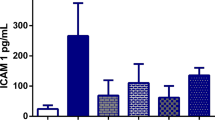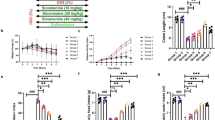Abstract
The hypouricemic actions of exopolysaccharide produced by Cordyceps militaris (EPCM) in potassium oxonate-induced hyperuricemia in mice were examined. Hyperuricemic mice were administered intragastrically with EPCM (200, 400 and 800 mg/kg body weight) or allopurinol (5 mg/kg body weight) once daily. Serum uric acid, blood urea nitrogen and liver xanthine oxidase (XOD) activities of each treatment were measured after administration for 7 days. EPCM showed dose-dependent uric acid-lowering actions. EPCM at a dose of 400 mg/kg body weight and allopurinol showed the same effect in serum uric acid, blood urea nitrogen and liver XOD activities in hyperuricemic mice. An increase in liver XOD activities was observed in hyperuricemic mice due to administration of EPCM at a dose of 200 mg/kg body weight. EPCM at a dose of 800 mg/kg body weight did not show significant effects on serum uric acid and XOD activities. We conclude that EPCM has a hypouricemic effect caused by decreases in urate production and the inhibition of XOD activities in hyperuricemic mice, and this natural product exhibited more potential efficacy than allopurinol in renal protection.




Similar content being viewed by others
References
Battelli MG, Abbondanza A, Musiani S, Buonamici L, Strocchi P, Tazzari PL, Gramantieri L, Stirpe F (1999) Determination of xanthine oxidase in human serum by a competitive enzyme-linked immunosorbent assay (ELISA). Clin Chim Acta 281:147–158. doi:10.1016/s0009-8981(98)00220-4
Borchers AT, Keen CL, Gershwin ME (2004) Mushrooms, tumors, and immunity: an update. Exp Biol Med 229(5):393–406
Chen X, Wu G, Huang Z (2013) Structural analysis and antioxidant activities of polysaccharides from cultured Cordyceps militaris. Int J Biol Macromol 58:18–22. doi:10.1016/j.ijbiomac.2013.03.041
El Ashry FEZZ, Mahmoud MF, El Maraghy NN, Ahmed AF (2012) Effect of Cordyceps sinensis and taurine either alone or in combination on streptozotocin induced diabetes. Food Chem Toxicol 50(3–4):1159–1165. doi:10.1016/j.fct.2011.12.020
Emmerson BT (1996) The management of gout. N Engl J Med 334(7):445–451. doi:10.1056/NEJM199602153340707
Hall IH, Scoville JP, Reynolds DJ, Simlot R, Duncan P (1990) Substituted cyclic imides as potential anti-gout agents. Life Sci 46(26):1923–1927. doi:10.1016/0024-3205(90)90507-n
Harris MD, Siegel LB, Alloway JA (1999) Gout and hyperuricemia. Am Fam Physician 59(4):925–934
Hou Al, Meng Q-f, An J-s, Zhu K, Feng Y, Feng L-r (2008) Isolation and purification of polysaccharides from Cordyceps minlitaris and its inhibition on the proliferation of rat glomerular mesangial cells. Chem Res Chin Univ 24(5):584–587. doi:10.1016/s1005-9040(08)60123-3
Huang J, Wang S, Zhu M, Chen J, Zhu X (2011) Effects of genistein, apigenin, quercetin, rutin and astilbin on serum uric acid levels and xanthine oxidase activities in normal and hyperuricemic mice. Food Chem Toxicol 49(9):1943–1947. doi:10.1016/j.fct.2011.04.029
Kageyama N (1971) A direct colorimetric determination of uric acid in serum and urine with uricase-catalase system. Clin Chim Acta 31(2):421–426. doi:10.1016/0009-8981(71)90413-x
Kirtane AJ, Leder DM, Waikar SS, Chertow GM, Ray KK, Pinto DS, Karmpaliotis D, Burger AJ, Murphy SA, Cannon CP, Braunwald E, Gibson CM, Grp TS (2005) Serum blood urea nitrogen as an independent marker of subsequent mortality among patients with acute coronary syndromes and normal to mildly reduced glomerular filtration rates. J Am Coll Cardiol 45(11):1781–1786. doi:10.1016/j.jacc.2005.02.068
Kong LD, Yang C, Ge F, Wang HD, Guo YS (2004) A Chinese herbal medicine ermiao wan reduces serum uric acid level and inhibits liver xanthine dehydrogenase and xanthine oxidase in mice. J Ethnopharmacol 93(2–3):325–330. doi:10.1016/j.jep.2004.04.008
Lee JS, Hong EK (2011) Immunostimulating activity of the polysaccharides isolated from Cordyceps militaris. Int J Biol Macromol 11(9):1226–1233. doi:10.1016/j.intimp.2011.04.001
Lee JS, Kwon JS, Won DP, Lee KE, Shin WC, Hong EK (2010) Study on macrophage activation and structural characteristics of purified polysaccharide from the liquid culture broth of Cordyceps militaris. Carbohydr Polym 82(3):982–988. doi:10.1016/j.carbpol.2010.06.025
Li SP, Song ZH, Dong TTX, Ji ZN, Lo CK, Zhu SQ, Tsim KWK (2004) Distinction of water-soluble constituents between natural and cultured Cordyceps by capillary electrophoresis. Phytomedicine 11(7–8):684–690. doi:10.1016/j.phymed.2003.07.011
Li SP, Zhang GH, Zeng Q, Huang ZG, Wang YT, Dong TTX, Tsim KWK (2006) Hypoglycemic activity of polysaccharide, with antioxidation, isolated from cultured Cordyceps mycelia. Phytomedicine 13(6):428–433. doi:10.1016/j.phymed.2005.02.002
Li SP, Zhao KJ, Ji ZN, Song ZH, Dong TTX, Lo CK, Cheung JKH, Zhu SQ, Tsim KWK (2003) A polysaccharide isolated from Cordyceps sinensis, a traditional Chinese medicine, protects PC12 cells against hydrogen peroxide-induced injury. Life Sci 73(19):2503–2513. doi:10.1016/s0024-3205(03)00652-0
Lin R, Liu H, Wu S, Pang L, Jia M, Fan K, Jia S, Jia L (2012) Production and in vitro antioxidant activity of exopolysaccharide by a mutant, Cordyceps militaris SU5-08. Int J Biol Macromol 51(1–2):153–157. doi:10.1016/j.ijbiomac.2012.04.011
Litwack G, Bothwell JW, Williams JN Jr., Elvehjem CA (1953) A colorimetric assay for xanthine oxidase in rat liver homogenates. J Biol Chem 200(1):303–310
Mau JL, Tsai SY, Tseng YH, Huang SJ (2005) Antioxidant properties of hot water extracts from Ganoderma tsugae murrill. LWT-Food Sci Technol 38(6):589–597. doi:10.1016/j.lwt.2004.08.010
Mourao PAS, Pereira MS (1999) Searching for alternatives to heparin-sulfated fucans from marine invertebrates. Trends Cardiovasc Med 9(8):225–232. doi:10.1016/s1050-1738(00)00032-3
Nishioka H, Fujii H, Sun B, Aruoma OI (2006) Comparative efficacy of oligonol, catechin and (−)-epigallocatechin 3-O-gallate in modulating the potassium bromate-induced renal toxicity in rats. Toxicology 226(2–3):181–187. doi:10.1016/j.tox.2006.06.017
Song L-Q, Yu S-M, Ma X-P, Jin L-X (2010) The protective effects of Cordyceps sinensis extract on extracellular matrix accumulation of glomerular sclerosis in rats. Afr J Pharm Pharmaco 4(7):471–478
Talke H, Schubert GE (1965) Enzymatic urea determination in the blood and serum in the warburg optical test. Klin Wochenschr 43:174–175. doi:10.1007/bf01484513
Tang Q-Y, Zhang C-X (2013) Data processing system (DPS) software with experimental design, statistical analysis and data mining developed for use in entomological research. Insect Sci 20(2):254–260. doi:10.1111/j.1744-7917.2012.01519.x
Terkeltaub RA (2003) Gout. N Engl J Med 349(17):1647–1655. doi:10.1056/NEJMcp030733
Unno T, Sugimoto A, Kakuda T (2004) Xanthine oxidase inhibitors from the leaves of Lagerstroemia speciosa (L.) Pers. J Ethnopharmacol 93(2):391–395. doi:10.1016/j.jep.2004.04.012
Wasser SP (2002) Medicinal mushrooms as a source of antitumor and immunomodulating polysaccharides. Appl Microbiol Biotechnol 60(3):258–274. doi:10.1007/s00253-002-1076-7
Yu RM, Song LY, Zhao Y, Bin W, Wang L, Zhang H, Wu YH, Ye WC, Yao XS (2004) Isolation and biological properties of polysaccharide CPS-1 from cultured Cordyceps militaris. Fitoterapia 75(5):465–472. doi:10.1016/j.fitote.2004.04.003
Zaidman BZ, Yassin M, Mahajna J, Wasser SP (2005) Medicinal mushroom modulators of molecular targets as cancer therapeutics. Appl Microbiol Biotechnol 67(4):453–468. doi:10.1007/s00253-004-1787-z
Zhao X, Li L (1993) Cordyceps sinensis in protection of the kidney from cyclosporine a nephrotoxicity. Zhonghua Yi Xue Za Zhi 73(7):410–412
Zhao X, Zhu JX, Mo SF, Pan Y, Kong LD (2006) Effects of cassia oil on serum and hepatic uric acid levels in oxonate-induced mice and xanthine dehydrogenase and xanthine oxidase activities in mouse liver. J Ethnopharmacol 103(3):357–365. doi:10.1016/j.jep.2005.08.040
Zhou X, Yao Y (2013) Unexpected nephrotoxicity in male ablactated rats induced by Cordyceps militaris: the involvement of oxidative changes. Evid-based Compl Alt 2013:786528. doi:10.1155/2013/786528
Zhu JS, Halpern GM, Jones K (1998) The scientific rediscovery of a precious ancient Chinese herbal regimen: Cordyceps sinensis-part II. J Altern Complement Med 4(4):429–457. doi:10.1089/acm.1998.4.429
Zhu JX, Wang Y, Kong LD, Yang C, Zhang X (2004) Effects of Biota orientalis extract and its flavonoid constituents, quercetin and rutin on serum uric acid levels in oxonate-induced mice and xanthine dehydrogenase and xanthine oxidase activities in mouse liver. J Ethnopharmacol 93(1):133–140. doi:10.1016/j.jep.2004.03.037
Acknowledgments
This work was supported by Guangdong Science and Technology Project (Grant No. 2007A020300008-6), as well as by Guangzhou Science and Technology Project (Grant No. 2012J4300129).
Author information
Authors and Affiliations
Corresponding author
Rights and permissions
About this article
Cite this article
Ma, L., Zhang, S., Yuan, Y. et al. Hypouricemic Actions of Exopolysaccharide Produced by Cordyceps militaris in Potassium Oxonate-Induced Hyperuricemic Mice. Curr Microbiol 69, 852–857 (2014). https://doi.org/10.1007/s00284-014-0666-9
Received:
Accepted:
Published:
Issue Date:
DOI: https://doi.org/10.1007/s00284-014-0666-9




